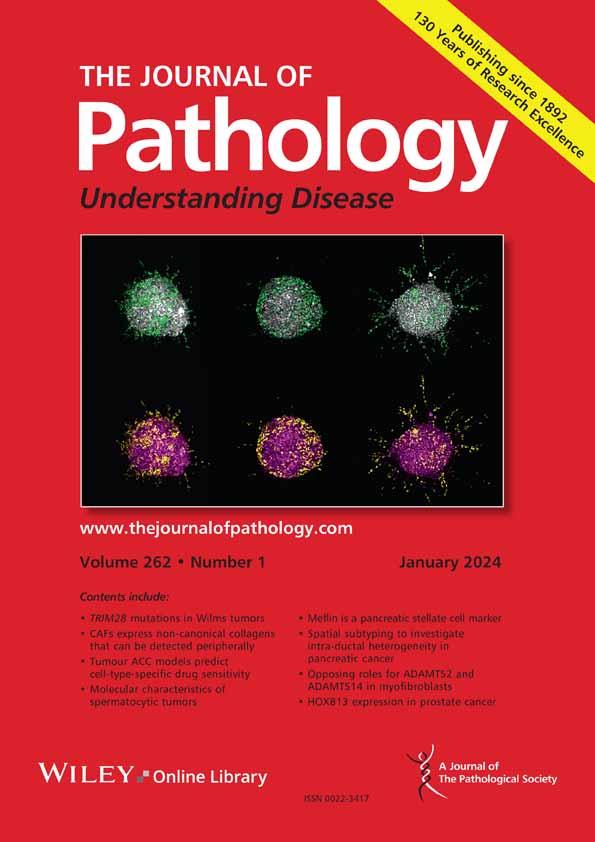SMARCB1-deficient malignant melanocytic uveal tumours: a new neural crest-derived tumour entity with SMARCB1-related germline predisposition
IF 5.2
2区 医学
Q1 ONCOLOGY
Joanna Cyrta, Julien Masliah-Planchon, Owen Hoare, Riwan Brillet, Mamy Andrianteranagna, Pierre Sohier, Liesbeth Cardoen, Yassine Bouchoucha, Mathilde Filser, Andreia Goncalves, Martial Caly, Paul Fréneaux, Kalliopi Stefanaki, Maria Pefkianaki, Maria Moschovi, Alexandre Matet, Nathalie Cassoux, Livia Lumbroso-Le Rouic, Marion Gauthier-Villars, Marc-Henri Stern, Anne Vincent-Salomon, Manuel Rodrigues, Franck Bourdeaut
下载PDF
{"title":"SMARCB1-deficient malignant melanocytic uveal tumours: a new neural crest-derived tumour entity with SMARCB1-related germline predisposition","authors":"Joanna Cyrta, Julien Masliah-Planchon, Owen Hoare, Riwan Brillet, Mamy Andrianteranagna, Pierre Sohier, Liesbeth Cardoen, Yassine Bouchoucha, Mathilde Filser, Andreia Goncalves, Martial Caly, Paul Fréneaux, Kalliopi Stefanaki, Maria Pefkianaki, Maria Moschovi, Alexandre Matet, Nathalie Cassoux, Livia Lumbroso-Le Rouic, Marion Gauthier-Villars, Marc-Henri Stern, Anne Vincent-Salomon, Manuel Rodrigues, Franck Bourdeaut","doi":"10.1002/path.6390","DOIUrl":null,"url":null,"abstract":"<p>Rhabdoid tumours (RT) are an aggressive malignancy affecting <2-year-old infants, characterised by biallelic loss-of-function alterations in SWI/SNF-related BAF chromatin remodelling complex subunit B1 (<i>SMARCB1</i>) in nearly all cases. Germline <i>SMARCB1</i> alterations are found in ~30% of patients and define the RT Predisposition Syndrome type 1 (RTPS1). Uveal melanoma (UVM), the most common primary intraocular cancer in adults, does not harbour <i>SMARCB1</i> alterations. We report two cases of a previously undescribed intraocular malignancy that shared some features with UVM and RT, but was also distinct from these entities. Both female patients, aged 23 and 14 years, underwent enucleation, and the tumours were subjected to comprehensive genomic, DNA methylation, and transcriptomic profiling. Pathological examination showed large, amelanotic intraocular tumours with epithelioid features, expressing melanocytic markers [S100P, SOX10, Melan-A, PMEL (HMB45), TYR] as seen using immunohistochemistry (IHC), but with little or no melanin production. Both tumours harboured biallelic loss-of-function <i>SMARCB1</i> alterations, associated with loss of SMARCB1 (BAF47/INI1) expression on IHC. Their genomic profiles were atypical both for UVM and for RT, and no pathogenic variants were found in other genes tested, including those recurrently altered in UVM. In both patients, a germline <i>SMARCB1</i> variant was found. However, there was no relevant family history of cancer. Transcriptome and methylome profiling suggested that these tumours were distinct from RT, UVM, and skin melanomas. RNAseq confirmed expression of early and late genes related to melanocytic differentiation. The first patient died of metastatic disease 16 months after diagnosis, the second was disease-free 10 months after completion of treatment. In summary, we report two cases of a previously undescribed, aggressive <i>SMARCB1</i>-deficient intraocular malignancy with melanocytic differentiation, which occurs in young patients, is distinct from UVM and RT, and expands the RTPS1 spectrum. © 2025 The Author(s). <i>The Journal of Pathology</i> published by John Wiley & Sons Ltd on behalf of The Pathological Society of Great Britain and Ireland.</p>","PeriodicalId":232,"journal":{"name":"The Journal of Pathology","volume":"265 3","pages":"357-371"},"PeriodicalIF":5.2000,"publicationDate":"2025-01-23","publicationTypes":"Journal Article","fieldsOfStudy":null,"isOpenAccess":false,"openAccessPdf":"https://onlinelibrary.wiley.com/doi/epdf/10.1002/path.6390","citationCount":"0","resultStr":null,"platform":"Semanticscholar","paperid":null,"PeriodicalName":"The Journal of Pathology","FirstCategoryId":"3","ListUrlMain":"https://pathsocjournals.onlinelibrary.wiley.com/doi/10.1002/path.6390","RegionNum":2,"RegionCategory":"医学","ArticlePicture":[],"TitleCN":null,"AbstractTextCN":null,"PMCID":null,"EPubDate":"","PubModel":"","JCR":"Q1","JCRName":"ONCOLOGY","Score":null,"Total":0}
引用次数: 0
引用
批量引用
Abstract
Rhabdoid tumours (RT) are an aggressive malignancy affecting <2-year-old infants, characterised by biallelic loss-of-function alterations in SWI/SNF-related BAF chromatin remodelling complex subunit B1 (SMARCB1 ) in nearly all cases. Germline SMARCB1 alterations are found in ~30% of patients and define the RT Predisposition Syndrome type 1 (RTPS1). Uveal melanoma (UVM), the most common primary intraocular cancer in adults, does not harbour SMARCB1 alterations. We report two cases of a previously undescribed intraocular malignancy that shared some features with UVM and RT, but was also distinct from these entities. Both female patients, aged 23 and 14 years, underwent enucleation, and the tumours were subjected to comprehensive genomic, DNA methylation, and transcriptomic profiling. Pathological examination showed large, amelanotic intraocular tumours with epithelioid features, expressing melanocytic markers [S100P, SOX10, Melan-A, PMEL (HMB45), TYR] as seen using immunohistochemistry (IHC), but with little or no melanin production. Both tumours harboured biallelic loss-of-function SMARCB1 alterations, associated with loss of SMARCB1 (BAF47/INI1) expression on IHC. Their genomic profiles were atypical both for UVM and for RT, and no pathogenic variants were found in other genes tested, including those recurrently altered in UVM. In both patients, a germline SMARCB1 variant was found. However, there was no relevant family history of cancer. Transcriptome and methylome profiling suggested that these tumours were distinct from RT, UVM, and skin melanomas. RNAseq confirmed expression of early and late genes related to melanocytic differentiation. The first patient died of metastatic disease 16 months after diagnosis, the second was disease-free 10 months after completion of treatment. In summary, we report two cases of a previously undescribed, aggressive SMARCB1 -deficient intraocular malignancy with melanocytic differentiation, which occurs in young patients, is distinct from UVM and RT, and expands the RTPS1 spectrum. © 2025 The Author(s). The Journal of Pathology published by John Wiley & Sons Ltd on behalf of The Pathological Society of Great Britain and Ireland.
smarcb1缺陷的恶性黑素细胞葡萄膜肿瘤:一种新的神经嵴源性肿瘤实体,具有smarcb1相关的种系易感性。
横纹肌样肿瘤是一种侵袭性恶性肿瘤
本文章由计算机程序翻译,如有差异,请以英文原文为准。
来源期刊
期刊介绍:
The Journal of Pathology aims to serve as a translational bridge between basic biomedical science and clinical medicine with particular emphasis on, but not restricted to, tissue based studies. The main interests of the Journal lie in publishing studies that further our understanding the pathophysiological and pathogenetic mechanisms of human disease.
The Journal of Pathology welcomes investigative studies on human tissues, in vitro and in vivo experimental studies, and investigations based on animal models with a clear relevance to human disease, including transgenic systems.
As well as original research papers, the Journal seeks to provide rapid publication in a variety of other formats, including editorials, review articles, commentaries and perspectives and other features, both contributed and solicited.






 求助内容:
求助内容: 应助结果提醒方式:
应助结果提醒方式:


